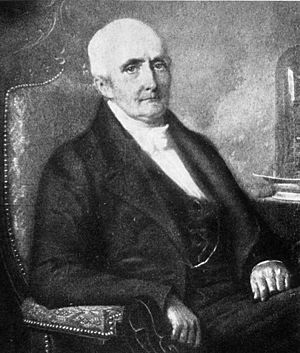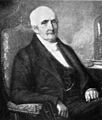Nicolas Théodore de Saussure facts for kids
Quick facts for kids
Nicolas-Théodore de Saussure
|
|
|---|---|
 |
|
| Born | 14 October 1767 Geneva, Republic of Geneva
|
| Died | 18 April 1845 (aged 77) Geneva, Switzerland
|
| Nationality | Genevan, and Swiss since 1815 |
| Scientific career | |
| Fields | Chemistry, phytochemistry, plant physiology, photosynthesis |
| Institutions | University of Geneva |
| Influences | Antoine Lavoisier, Jean Senebier, Charles Bonnet |
| Influenced | Justus von Liebig, Jean-Baptiste Boussingault |
| Author abbrev. (botany) | N.T.Sauss. |
Nicolas-Théodore de Saussure (born October 14, 1767 – died April 18, 1845) was a Swiss chemist and a scientist who studied how plants work. He made big discoveries in phytochemistry, which is the chemistry of plants. He was also a key pioneer in understanding photosynthesis, the process plants use to make their own food.
Contents
About Nicolas-Théodore de Saussure
Nicolas-Théodore de Saussure came from a rich family in Geneva, Switzerland. Many people in his family were good at science, especially studying plants. His father, Horace-Bénédict de Saussure, was a famous geologist and explorer. His great uncle, Charles Bonnet, was also a well-known naturalist who studied plant leaves.
Nicolas-Théodore was called "Théodore" to tell him apart from his grandfather, who had the same name. He published his scientific papers using the name Théodore de Saussure after his father passed away.
Early Life and Education
Théodore and his siblings were taught at home. Their father believed the schools at that time were not good enough. From 1782 to 1786, Théodore went to the University of Geneva. There, he studied math, science, and history.
During the early years of the French Revolution, he traveled a lot. He met important scientists in London and Paris. In Paris, he took chemistry classes and shared his own research.
Later Life and Work
When he returned to Geneva in 1802, he became an honorary professor at the University of Geneva. He taught very little but stayed on the faculty until 1835. He preferred to do his research quietly in his own private laboratory.
Like others in his family, Théodore was active in public life in Geneva. He served on the city's representative council, helping to make decisions for the community.
His sister, Albertine Necker de Saussure, was an important writer. She wrote about how to educate women. Nicolas-Théodore did not have children of his own. However, he was the great uncle of Ferdinand de Saussure, a very important linguist (someone who studies language).
Scientific Discoveries and Contributions
When he was young, Nicolas-Théodore went on trips with his father to the Alps mountains. He helped his father with experiments in physics, chemistry, and weather. In one experiment, he proved Boyle's law. This law describes how gas pressure and volume are related. He did this by weighing a sealed bottle at different heights.
He also named the mineral dolomite in 1792. He named it after another scientist, Déodat Gratet de Dolomieu.
Plant Chemistry and Photosynthesis
Nicolas-Théodore became very interested in chemistry because of Antoine Lavoisier's new discoveries. He started studying the chemistry of plants. He looked at how plants exchange gases and how different soils affected their growth.
His most important book, Recherches chimiques sur la Végétation ("Chemical Research on Plant Growth"), was published in 1804. This book was the first to explain the basic process of photosynthesis. It greatly helped people understand how plants work. Unlike earlier scientists, Saussure used a lot of careful measurements and data for his conclusions.
How Plants Grow
In his book, Saussure showed that plants gain weight not just from taking in CO2. They also gain weight from using water to build their bodies. He proved this by growing plants with their roots in water and their leaves in air with extra CO2. The plants gained much more weight than could come from just the CO2. This showed the extra weight came from the water.
Saussure also proved that plants get their carbon from the carbon dioxide in the air. Before him, many scientists thought plants got carbon from the soil. He also showed that plants need minerals from the soil to grow. His work helped complete the basic chemical equation for photosynthesis. This equation shows that plants use carbon dioxide and water with sunlight to make food (like glucose) and release oxygen.
Because of his work, Saussure is seen as the last of the first major scientists to study photosynthesis. He built on the work of others like Joseph Priestley and Jan Ingenhousz.
Impact on Science and Agriculture
For many years after Saussure's book was published, his findings were not widely recognized. But then, a famous German chemist named Justus von Liebig rediscovered his work. Also, a French agricultural chemist, Jean-Baptiste Boussingault, confirmed Saussure's ideas about how important minerals from the soil are for plants.
Saussure's discoveries have had a big impact on many fields. These include chemistry, farming, soil science, and plant nutrition. He is considered one of the founders of modern agriculture.
Other Chemical Studies
Besides studying plants, Nicolas-Théodore also made progress in analyzing organic substances. He figured out what alcohol and ether are made of. He also studied fermentation (how things like sugar turn into alcohol) and how starches turn into sugars.
In 1815, he helped start the Société Helvétique des Sciences Naturelles (which is now the Swiss Academy of Natural Sciences).
Honors and Recognition
Nicolas-Théodore de Saussure received many honors for his scientific work:
- 1808: Correspondent of the First Class of the French Institute.
- 1812: Member of the Royal Institute of the Netherlands.
- 1820: Fellow of the Royal Society of London.
- 1820: Member of the Bavarian Academy of Sciences and Humanities.
- 1830: Foreign member of the Institute of Bologna.
- 1837: The plant genera Saussurea and Saussuria were named after him.
- 1842: Elected president of the Congrés Scientifique de Lyons.
Images for kids
See also
 In Spanish: Nicolas-Théodore de Saussure para niños
In Spanish: Nicolas-Théodore de Saussure para niños


